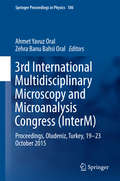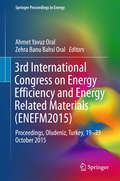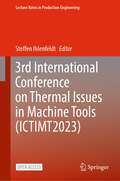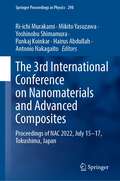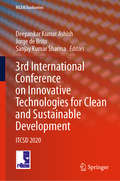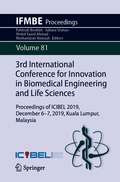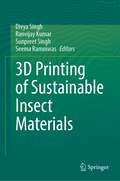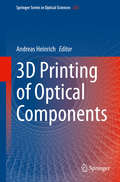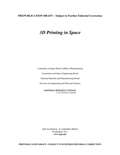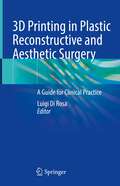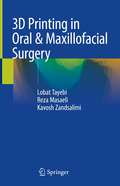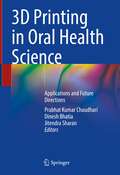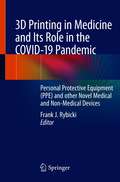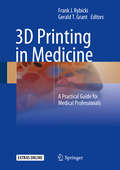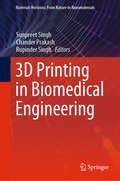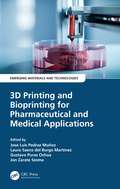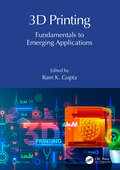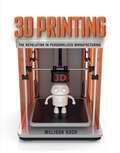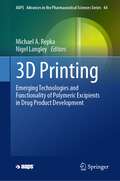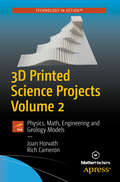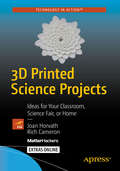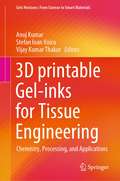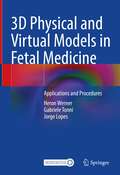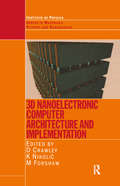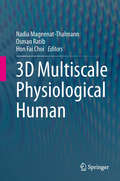- Table View
- List View
3rd International Multidisciplinary Microscopy and Microanalysis Congress: Proceedings, Oludeniz, Turkey, 19-23 October 2015 (Springer Proceedings in Physics #186)
by Ahmet Yavuz Oral Zehra Banu Bahsi OralThe 3rd International Multidisciplinary Microscopy Congress (InterM2015), held from 19 to 23 October 2015, focused on the latest developments concerning applications of microscopy in the biological, physical and chemical sciences at all dimensional scales, advances in instrumentation, techniques in and educational materials on microscopy. These proceedings gather 17 peer-reviewed technical papers submitted by leading academic and research institutions from nine countries and representing some of the most cutting-edge research available.
3rd International Congress on Energy Efficiency and Energy Related Materials: Proceedings, Oludeniz, Turkey, 19–23 October 2015 (Springer Proceedings in Energy)
by Ahmet Yavuz Oral Zehra Banu Bahsi OralThe 3rd International Congress on Energy Efficiency and Energy Related Materials (ENEFM2015) was held from 19-23 October 2015. This congress focused on the latest developments of sustainable energy technologies, materials for sustainable energy applications and environmental and economic perspectives of energy. These proceedings included 40 peer-reviewed technical papers, submitted by leading academic and research institutions from over 23 countries and represented some of the most cutting-edge researches available. The sections included in the 40 papers are listed as follows: Solar Energy, Fuel cells, Hydrogen productions, Hydrogen storage, Energy storage, Energy saving, Biofuels and Bioenergy, Wind Energy, Nuclear Energy, Fossil Energy, Hydropower, Carbon capture and storage, Materials for renewable energy storage and conversion, Photovoltaics and solar cells, Fuel generation from renewables (catalysis), Carbon dioxide sequestration and conversion, Materials for energy saving, Thermoelectrics, Energy saving in buildings, Bio-Assessment and Toxicology, Air pollution from mobile and stationary sources, Transport of Air Pollutants, Environment-Friendly Construction and Development, Energy Management Systems.
3rd International Conference on Thermal Issues in Machine Tools (Lecture Notes in Production Engineering)
by Steffen IhlenfeldtThis open access conference proceedings contains all the papers presented at the ICTIMT 2023, the 3rd International Conference on Thermal Issues in Machine Tools. The event takes place in Dresden, the capital of Saxony, from March 21-23 2023. The conference is organized by the Chair of Machine Tools Development and Adaptive Controls of the Technische Universität Dresden.
The 3rd International Conference on Nanomaterials and Advanced Composites: Proceedings of NAC 2022, July 15-17, Tokushima, Japan (Springer Proceedings in Physics #298)
by Ri-Ichi Murakami Mikito Yasuzawa Yoshinobu Shimamura Pankaj Koinkar Hairus Abdullah Antonio NakagaitoThis book presents selected articles from the 3rd International Conference on Nanomaterials and Advanced Composites (NAC 2022) held at Tokushima University in Japan. This event brought together leading researchers and professionals from academia and industry to present their latest findings and served as a platform for the exchange of ideas aiming for further collaborations. Participants from over six countries shared their most up-to-date knowledge in their respective fields covering nanotechnology, nanomaterials, and advanced composites. Even though this conference had both on-site and remotely connected attendees, the main purpose to promote the networking among academics, engineers, and students was fully achieved. This book is part of the effort to disseminate the knowledge gathered during this meeting. The collection of articles covers topics on advanced composites, nanomaterials, ecological materials, energy, microfluidics, crystal growth, and photocatalysis. This representative account of the conference is intended to provide new and useful insights for prospective studies in materials science and engineering.
3rd International Conference on Innovative Technologies for Clean and Sustainable Development: ITCSD 2020 (RILEM Bookseries #29)
by Deepankar Kumar Ashish Jorge De Brito Sanjay Kumar SharmaThis book gathers peer-reviewed contributions presented at the 3rd International Conference on Innovative Technologies for Clean and Sustainable Development, held in Chandigarh, India, on February 19-21, 2020. The respective papers focus on sustainable materials science and cover topics including the durability and sustainability of concrete, green materials in construction, economics of cleaner production, environmental impact mitigation, innovative materials for sustainable construction, performance and sustainability of special concrete, renewable energy infrastructure, sustainability in road construction, sustainable concrete, sustainable construction materials, waste minimization & management, prevention and management of water pollution, and zero-energy buildings.
3rd International Conference for Innovation in Biomedical Engineering and Life Sciences: Proceedings of ICIBEL 2019, December 6-7, 2019, Kuala Lumpur, Malaysia (IFMBE Proceedings #81)
by Fatimah Ibrahim Juliana Usman Mohd Yazed Ahmad Norhamizan HamzahThis book presents innovative engineering solution for medical diagnosis, therapy and life science studies. Gathering the proceedings of the 3rd International Conference for Innovation in Biomedical Engineering and Life Sciences, ICIBEL 2020, held on December 6-7, 2019, in Kuala Lumpur, Malaysia, this book aims at informing on engineering tools and their clinical applications, and being a source of inspiration for future research and interdisciplinary collaborations.
3D Printing of Sustainable Insect Materials
by Divya Singh Ranvijay Kumar Sunpreet Singh Seema RamniwasThis book compiles a diverse and interdisciplinary range of scientific literature, laboratory developments, industrial implications and future prospects covering Entomophagy in 3D food printing to fight against hunger and nutritional deficiencies. Recent developments in Entomphagy in 3D printing of Drosophila based materials, and their nutritional, social, economic, scientific and environmental aspects. are comprehensively covered. Readers will also find shortcomings, guidelines, and industrial prospects for these materials, with emphasis on processing methods for the extraction of sustainable materials through 3D food printing. 3D Printing of Sustainable Insect Materials focuses on the methodology, technology and processing used for utilizing insects in 3D food printing applications, establishing technology-driven knowledge to fight against hunger. Chapters cover the principles for Entomophagy, insect processing methods, modern 3D food printing technologies, and the theoretical and practical aspects of Emtomophagy in 3D printing, with a special focus on future prospects and technologies. This ground-breaking book will serve knowledge to researchers and industry professionals across the food industry with broad coverage of emerging technologies, materials developed through Entomophagy, functional characterization and the technical details required to produce sustainable insect-based materials through 3D food printing.
3D Printing of Optical Components (Springer Series in Optical Sciences #233)
by Andreas HeinrichThis edited volume reviews the current state of the art in the additive manufacturing of optical componentry, exploring key principles, materials, processes and applications. A short introduction lets readers familiarize themselves with the fundamental principles of the 3D printing method. This is followed by a chapter on commonly-used and emerging materials for printing of optical components, and subsequent chapters are dedicated to specific topics and case studies. The high potential of additive manufactured optical components is presented based on different manufacturing techniques and accompanied with extensive examples – from nanooptics to large scale optics – and taking research and industrial perspectives. Readers are provided with an extensive overview of the new possibilities brought about by this alternative method for optical components manufacture. Finally, the limitations of the method with respect to manufacturing techniques, materials and optical properties of the generated objects are discussed. With contributions from experts in academia and industry, this work will appeal to a wide readership, from undergraduate students through engineers to researchers interested in modern methods of manufacturing optical components.
3D Printing in Space
by Committee on Space-Based Additive ManufacturingAdditive manufacturing has the potential to positively affect human spaceflight operations by enabling the in-orbit manufacture of replacement parts and tools, which could reduce existing logistics requirements for the International Space Station and future long-duration human space missions. The benefits of in-space additive manufacturing for robotic spacecraft are far less clear, although this rapidly advancing technology can also potentially enable space-based construction of large structures and, perhaps someday, substantially in the future, entire spacecraft. Additive manufacturing can also help to reimagine a new space architecture that is not constrained by the design and manufacturing confines of gravity, current manufacturing processes, and launch-related structural stresses. The specific benefits and potential scope of additive manufacturing remain undetermined. The realities of what can be accomplished today, using this technology on the ground, demonstrate the substantial gaps between the vision for additive manufacturing in space and the limitations of the technology and the progress that has to be made to develop it for space use. "3D Printing in Space" evaluates the prospects of in-space additive manufacturing. This report examines the various technologies available and currently in development, and considers the possible impacts for crewed space operations and robotic spacecraft operations. Ground-based additive manufacturing is being rapidly developed by industry, and "3D Printing in Space" discusses government-industry investments in technology development. According to this report, the International Space Station provides an excellent opportunity for both civilian and military research on additive manufacturing technology. Additive manufacturing presents potential opportunities, both as a tool in a broad toolkit of options for space-based activities and as a potential paradigm-changing approach to designing hardware for in-space activities. This report makes recommendations for future research, suggests objectives for an additive manufacturing roadmap, and envisions opportunities for cooperation and joint development.
3D Printing in Plastic Reconstructive and Aesthetic Surgery: A Guide for Clinical Practice
by Luigi Di RosaThis handy volume illustrates the basics of clinical three-dimensional (3D) printing, addressing the practical aspects of establishing a simple and effective 3D printing service in a medical facility. No longer confined to makers and workshops, this very recent technology has been fast developing and rapid prototyping has proven its potential in the clinical field as well, leading to new approaches. The declared aim of this work is enabling medical professionals to create bespoke anatomical models from a series of CT or MRI images, and assisting them in choosing the best suited 3D printers and materials for each specific clinical need. The text includes original, full-color step-by-step photos for better guidance, and a complete review of related publications in literature. Single chapters devoted to specific areas of 3D printing application, such as rhinoplasty, ear reconstruction, oculoplasty, maxillofacial surgery, as well as for surgical simulations. Contents are completed by a review of the legal aspects and the safety and quality considerations, as well as a thorough examination of the variety of 3D printers, compatible materials as filaments and resins, and including the available online resources. Plastic, Ophthalmologic and Maxillofacial surgeons, and professionals dealing with surgical reconstruction, will find this guide to be a valuable companion for the understanding of 3D printing in clinical practice.
3D Printing in Oral & Maxillofacial Surgery
by Lobat Tayebi Reza Masaeli Kavosh ZandsalimiThis book is a comprehensive guide to 3D printing and 3D bioprinting methods and their application in oral and maxillofacial surgeries. Among the 3D printing methods considered are fused deposition modeling, selective laser sintering, photopolymer jetting, powder binder printing, and stereolithography, while the coverage of 3D bioprinting encompasses inkjet, microextrusion, and laser techniques. In each case, the relevance of the technique to oral and maxillofacial surgery is explained. In addition, the available inks and bioinks for 3D printing are reviewed. The roles of soft and hard tissue printing in oral and maxillofacial tissue engineering and the use of 3D printing in multi- and interfacial tissue engineering are then examined in depth. The particular value of 3D printing in the treatment of critically sized defects is discussed separately. Finally, up-to-date information is provided on guided tissue/bone regeneration using 3D printing. The book will be of interest to both oral and maxillofacial surgeons and biomedical engineers.
3D Printing in Oral Health Science: Applications and Future Directions
by Prabhat Kumar Chaudhari Dinesh Bhatia Jitendra SharanThis book on 3D printing in oral health science aims to equip the reader with a sound understanding of contemporary clinical applications in all fields of dentistry and their future directions. In the last few years, the development of 3D printing for medical and dental applications has increased tremendously. Advancements in 3D printing create the possibility of customized products, savings on small-scale productions, ease of sharing and processing of patient image data, and educational up-gradation. Looking at the dental specialties, it is evident that 3D printing has applications in all aspects of oral health science including prosthodontics, oral surgery, periodontics, endodontics, and orthodontics. This book will cover all major fields in dentistry and will help the practitioner in the process of decision-making and apply concepts in clinical or laboratory practice. It is based on current scientific evidence to provide readers with an up-to-date contemporary understanding of the subject, both from the clinical and the technological side. The book is a valuable asset for all who specialize in 3D printing and for those interested in learning more about this field.
3D Printing in Medicine and Its Role in the COVID-19 Pandemic: Personal Protective Equipment (PPE) and other Novel Medical and Non-Medical Devices
by Frank J. RybickiThis book describes how “makers” with no medical experience became and remain clinically important because they utilized 3D printing to produce supplies for healthcare, including medical and non-medical devices, and to improve the quality of life for patients with COVID-19 and those who care for them. It shows how 3D printing became vital during the pandemic due to its broad availability and the inherently digital nature of the work that enables thriving digital exchanges and work in isolation. Subsequent chapters highlight some of the “maker” communities' efforts that made a difference in their part of North America. Each contribution describes the unique experiences, challenges, and successes.While this book is written and edited mostly from a medical perspective, additional input from medical engineers, administrators, attorneys, and public safety officials enables a broad perspective to highlight some of the ingenuity from the North American 3D printing community who responded to the initial case volumes of COVID-19.
3D Printing in Medicine: A Practical Guide for Medical Professionals
by Frank J. Rybicki Gerald T. GrantThis book describes the fundamentals of three-dimensional (3D) printing, addresses the practical aspects of establishing a 3D printing service in a medical facility, and explains the enormous potential value of rendering images as 3D printed models capable of providing tactile feedback and tangible information on both anatomic and pathologic states. Individual chapters also focus on selected areas of applications for 3D printing, including musculoskeletal, craniomaxillofacial, cardiovascular, and neurosurgery applications. Challenges and opportunities related to training, materials and equipment, and guidelines are addressed, and the overall costs of a 3D printing lab and the balancing of these costs against clinical benefits are discussed. Radiologists, surgeons, and other physicians will find this book to be a rich source of information on the practicalities and expanding medical applications of 3D printing.
3D Printing in Biomedical Engineering (Materials Horizons: From Nature to Nanomaterials)
by Sunpreet Singh Chander Prakash Rupinder SinghThis book gives a comprehensive overview of the rapidly evolving field of three-dimensional (3D) printing, and its increasing applications in the biomedical domain. 3D printing has distinct advantages like improved quality, cost-effectiveness, and higher efficiency compared to traditional manufacturing processes. Besides these advantages, current challenges and opportunities regarding choice of material, design, and efficiency are addressed in the book. Individual chapters also focus on select areas of applications such as surgical guides, tissue regeneration, artificial scaffolds and implants, and drug delivery and release. This book will be a valuable source of information for researchers and professionals interested in the expanding biomedical applications of 3D printing.
3D Printing and Bioprinting for Pharmaceutical and Medical Applications (Emerging Materials and Technologies)
by Jose Luis Pedraz Muñoz Laura Saenz del Burgo Martínez Gustavo Puras Ochoa Jon Zarate SesmaThe increasing availability and decreasing costs of 3D printing and bioprinting technologies are expanding opportunities to meet medical needs. 3D Printing and Bioprinting for Pharmaceutical and Medical Applications discusses emerging approaches related to these game-changer technologies in such areas as drug development, medical devices, and bioreactors. Key Features: Offers an overview of applications, the market, and regulatory analysis Analyzes market research of 3D printing and bioprinting technologies Reviews 3D printing of novel pharmaceutical dosage forms for personalized therapies and for medical devices, as well as the benefits of 3D printing for training purposes Covers 3D bioprinting technology, including the design of polymers and decellularized matrices for bio-inks development, elaboration of 3D models for drug evaluation, and 3D bioprinting for musculoskeletal, cardiovascular, central nervous system, ocular, and skin applications Provides risk-benefit analysis of each application Highlights bioreactors, regulatory aspects, frontiers, and challenges This book serves as an ideal reference for students, researchers, and professionals in materials science, bioengineering, the medical industry, and healthcare.
3D Printing: Fundamentals to Emerging Applications
by Ram K Gupta3D Printing: Fundamentals to Emerging Applications discusses the fundamentals of 3D-printing technologies and their emerging applications in many important sectors such as energy, biomedicals, and sensors. Top international authors in their fields cover the fundamentals of 3D-printing technologies for batteries, supercapacitors, fuel cells, sensors, and biomedical and other emerging applications. They also address current challenges and possible solutions in 3D-printing technologies for advanced applications. Key features: Addresses the state-of-the-art progress and challenges in 3D-printing technologies Explores the use of various materials in 3D printing for advanced applications Covers fundamentals of the electrochemical behavior of various materials for energy applications Provides new direction and enables understanding of the chemistry, electrochemical properties, and technologies for 3D printing This is a must-have resource for students as well as researchers and industry professionals working in energy, biomedicine, materials, and nanotechnology.
3D Printing: The Revolution in Personalized Manufacturing
by Melissa Koch3D printing was once only known through science fiction, such as Star Trek, the popular 1960s TV series. But inventors and engineers on Earth began experimenting in real life with 3D printing to find faster ways to develop and build prototypes, using computers, ultraviolet lasers, and printable materials. Now, there are many innovative uses for 3D printing. Yet 3D printing has drawbacks. Chemicals used in 3D printing can be toxic, and legal experts are not sure how to protect 3D printing inventions so that others do not steal ideas. Learn how 3D printing works and how we can keep up with the safety, health, and legal challenges that lie ahead.
3D Printing: Emerging Technologies and Functionality of Polymeric Excipients in Drug Product Development (AAPS Advances in the Pharmaceutical Sciences Series #44)
by Michael A. Repka Nigel LangleyThis inclusive text describes 3D Printing for pharmaceutical applications, including emerging 3D technologies. The book focuses on the functionality of the materials/biomaterials used for the preparation of dosage forms and devices, fundamentals for preparing these systems and novel applications using these additive manufacturing techniques. Also, the text includes clinical relevance and regulatory considerations for the future of personalized medicine.Authored by experts with a broad range of experience, extensive insight into the science of 3D printing technology used to produce these systems is provided. Highlighting viewpoints from the academic, polymer excipient, equipment, product development and regulatory communities, this comprehensive text compiles input from industry thought leaders to illustrate strategies and technologies for applying techniques of additive manufacturing for drug product and device development while also providing insight into the path forward for the technology in years to come.
3D Printed Science Projects Volume 2: Physics, Math, Engineering and Geology Models
by Joan Horvath Rich CameronLearn physics, engineering, and geology concepts usually seen in high school and college in an easy, accessible style. This second volume addresses these topics for advanced science fair participants or those who just like reading about and understanding science. 3D Printed Science Project Volume 2 describes eight open-source 3D printable models, as well as creative activities using the resulting 3D printed pieces. The files are designed to print as easily as possible, and the authors give tips for printing them on open source printers. As 3D printers become more and more common and affordable, hobbyists, teachers, parents, and students stall out once they've printed some toys and a few household items. To get beyond this, most people benefit from a "starter set" of objects as a beginning point in their explorations, partially just to see what is possible. This book tells you the solid science stories that these models offer, and provides them in open-source repositories. What You Will Learn: Create (and present the science behind) 3D printed models Review innovative ideas for tactile ways to learn concepts in engineering, geology and physics Learn what makes a models easy or hard to 3D print Who This Book Is For: The technology- squeamish teacher and parents who want their kids to learn something from their 3D printer but don't know how, as well as high schoolers and undergraduates.
3D Printed Science Projects: Ideas for your classroom, science fair or home
by Joan Horvath Rich Cameron3D Printed Science Projects describes how to create 3D printable models that can help students from kindergarten through grad school learn math, physics, botany, chemistry, engineering and more. Each of the eight topics is designed to be customized by the reader to create a wide range of projects suitable for science fairs, extra credit, or classroom demonstrations. Science fair project suggestions and extensive "where to learn more" resources are included, too. You will add another dimension to your textbook understanding of science. What you'll learn To create (and present the science behind) 3D printed models. To use a 3D printer to create those models as simply as possible. New science insights from designing 3D models. Who this book is for This book shows parents and teachers how to use the models inside as starting points for 3D printable explorations. Students can start with these models and vary them for their own explorations. Unlike other sets of models that can just be scaled, these models have the science built-in to allow for more insight into the fundamental concepts. Topics covered in this book: 3D Math Functions Light and Other Waves Gravity Airfoils Simple Machines Plants and their Ecosystems Molecules Trusses
3D printable Gel-inks for Tissue Engineering: Chemistry, Processing, and Applications (Gels Horizons: From Science to Smart Materials)
by Anuj Kumar Stefan Ioan Voicu Vijay Kumar ThakurThis book provides the necessary fundamentals and background for researchers and research professionals working in the field of 3D bioprinting in tissue engineering. In 3D bioprinting, design and development of the biomaterial-inks/bio-inks is a major challenge in providing 3D microenvironments specific to anatomical and architectural demands of native tissues. The focal point of this book is to provide the basic chemistry of biomaterials, updates on current processing, developments, and challenges, and recent advancements in tissue-specific 3D printing/bioprinting. This book is will serve as a go-to reference on bioprinting and is ideal for students, researchers and professionals, working academia, government, the medical industry, and healthcare.
3D Physical and Virtual Models in Fetal Medicine: Applications and Procedures
by Heron Werner Gabriele Tonni Jorge LopesTechnological innovations accompanying advances in medicine have given rise to the possibility of obtaining better-defined fetal images that assist in medical diagnosis and contribute toward genetic counseling offered to parents during the prenatal care. 3D printing is an emerging technique with a variety of medical applications such as surgical planning, biomedical research and medical education.Clinical Relevance: 3D physical and virtual models from ultrasound and magnetic resonance imaging have been used for educational, multidisciplinary discussion and plan therapeutic approaches. The authors describe techniques that can be applied at different stages of pregnancy and constitute an innovative contribution to research on fetal abnormalities. We will show that physical models in fetal medicine can help in the tactile and interactive study of complex abnormalities in multiple disciplines. They may also be useful for prospective parents because a 3D physical model with the characteristics of the fetus should allow a more direct emotional connection to their unborn child.
3D Nanoelectronic Computer Architecture and Implementation (Series in Material Science and Engineering)
by K. Nikolic M. Forshaw David CrawleyIt is becoming increasingly clear that the two-dimensional layout of devices on computer chips hinders the development of high-performance computer systems. Three-dimensional structures will be needed to provide the performance required to implement computationally intensive tasks. 3-D Nanoelectronic Computer Architecture and Implementation reviews the state of the art in nanoelectronic device design and fabrication and discusses the architectural aspects of 3-D designs, including the possible use of molecular wiring and carbon nanotube interconnections. This is a valuable reference for those involved in the design and development of nanoelectronic devices and technology.
3D Multiscale Physiological Human
by Nadia Magnenat-Thalmann Osman Ratib Hon Fai Choi3D Multiscale Physiological Human aims to promote scientific exchange by bringing together overviews and examples of recent scientific and technological advancements across a wide range of research disciplines. As a result, the variety in methodologies and knowledge paradigms are contrasted, revealing potential gaps and opportunities for integration. Chapters have been contributed by selected authors in the relevant domains of tissue engineering, medical image acquisition and processing, visualization, modeling, computer aided diagnosis and knowledge management. The multi-scale and multi-disciplinary research aspects of articulations in humans are highlighted, with a particular emphasis on medical diagnosis and treatment of musculoskeletal diseases and related disorders. The need for multi-scale modalities and multi-disciplinary research is an emerging paradigm in the search for a better biological and medical understanding of the human musculoskeletal system. This is particularly motivated by the increasing socio-economic burden of disability and musculoskeletal diseases, especially in the increasing population of elderly people. Human movement is generated through a complex web of interactions between embedded physiological systems on different spatiotemporal scales, ranging from the molecular to the organ level. Much research is dedicated to the understanding of each of these systems, using methods and modalities tailored for each scale. Nevertheless, combining knowledge from different perspectives opens new venues of scientific thinking and stimulates innovation. Integration of this mosaic of multifaceted data across multiple scales and modalities requires further exploration of methods in simulations and visualization to obtain a comprehensive synthesis. However, this integrative approach cannot be achieved without a broad appreciation for the multiple research disciplines involved.
